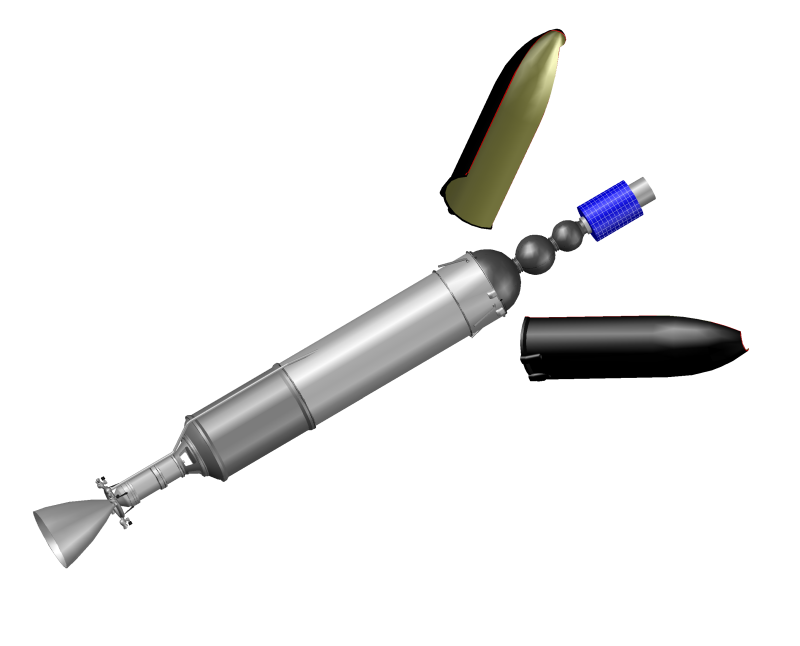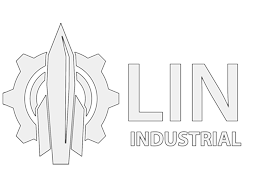Taymyr microsat launch vehicle

Taymyr-7 launch vehicle internal layout
The Taymyr family of modular microsat launch vehicles with payloads between 10 kg and 180 kg to LEO
Taymyr is the primary project of Lin Industrial. It was positively assessed by the experts from the Space Technologies and Telecommunications Cluster of the Skolkovo Foundation.
Taymyr launch vehicle will make the space affordable for everyone – it will launch into orbit nanosats and microsats (up to 180 kg) and 1 kg of payload will cost within $60,000 for customer.
Why a small launch vehicle?
The last decade has seen a trend of shifting from heavy satellites weighing multiple tons to satellites in micro- and nano- classes. The development of smallsat (100-500 kg), microsat (10-100 kg) and nanosat (1-10 kg) platforms is seen around the world. Both private and state-owned companies and educational institutions are involved in the creation of such satellites.
Russian private companies Dauria and SPUTNIX are also developing microsats and nanosats. SPUTNIX launched Tabletsat-Aurora, the first Russian private satellite (26 kg), while Dauria launched two satellites of Perseus-M series (5 kg each) and one DX-1 (15 kg). OJSC Russian Space Systems launched TNS-0 #1 nanosat (5 kg) for technology development.
Russian universities are also catching up. Mozhayskiy Academy launched multiple satellites. For instance, the latest Mozhaets-5 satellite weighs 73 kg. MSU launched Tatiana (32 kg) and Tatiana-II (90 kg), and Ufa State Aviation Technical University launched UGATUSAT (40 kg). MAI launched MAK-1 and MAK-2 satellites (20 kg each), and in partnership with Southwest State University was involved in the development of Radioskaf series of satellites (up to 100 kg).
The number of new satellites developed in Russia will likely continue to grow. In addition to the ongoing development in universities (next Radioskaf, Baumanets-2 etc.), here are some projects by private companies:
- Cluster-T scientific experiment for detecting gamma-ray bursts from outer space and from the Earth (Dauria + Space Research Institute of the Russian Academy of Sciences) — 3 to 4 microsats;
- microsat constellation for emergency monitoring (SPUTNIX and ScanEx for EMERCOM of Russia) — 18 microsats;
- Yaliny, global low cost Internet access — 135 microsats + 9 backups.
Russia goes in line with global trends.
For example, the charts below show the growth of the number of small satellites in different classes.
Figure 1. Number of launched satellites weighing from 1 to 50 kg (historic records and forecast)

Source: Spaceworks
Figure 2. Number of launched CubeSats (1-10 kg), including CubeSats lost during launch

Source: Saint Louis University
At the same time, there are no small satellite launch vehicles both in Russia and around the world. Payloads offered by small-lift launch vehicles (like Soyuz-2-1v, Rockot etc.) and especially by medium-lift and heavy-lift launch vehicles are excessive for launching individual microsats and nanosats. Thus, the lightest of current launch vehicles today is Pegasus XL, which lifts 443 kg to LEO. Therefore small satellites are launched on such launch vehicles as secondary payloads together with primary satellites, or in multiples (cluster launch).
When launching as secondary payloads, delays in preparing the primary payload often lead to delays in the secondary payloads launch. Adherence to a launch schedule is particularly critical when deploying orbital constellations of multiple satellites. For example, a breach of schedule for a launch of small technology satellites leads to direct financial losses, since the delay in technology validation slows down the development of commercial satellites on its base.
Another disadvantage is that when launching as a secondary payload the orbit is chosen by the primary payload customer. Specific orbit is critical for some satellites. So, for photographic remote sensing of the Earth, a sun-synchronous orbit is usually chosen. In 2013 there was no launch into a sun-synchronous orbit, so it was simply unreachable for a secondary payload.
Finally, the third limitation for secondary payloads and cluster launches is inability to use high-energy hardware. Therefore a satellite can not use any chemical rocket engines, pyrotechnics (this, for instance, limits the possibility of large-scale structures, LF antennas) and high pressure tanks.
All these problems can be solved by developing a launch vehicle specific for nanosats (1 to 10 kg) and microsats (10 to 100 kg).
Launch vehicle design
We propose to create a launch vehicle, or rather an entire Taymyr family of microsat launch vehicles with payloads of 10 to 180 kg to LEO.
These launch vehicles will allow customers to launch their microsats and nanosats within 3 months (rather than 9 months of the closest competitor) into any LEO (including polar orbits) or a sun-synchronous orbit with no limitations to the satellite design.
The propellant supply subsystem is a pressure-fed system, allowing to drastically simplify the launch vehicle design and its pneumohydraulic scheme, eliminate relatively expensive turbopump, improve the reliability and reduce the development costs. This comes at a price: it makes the design heavier. Replacing metals with light-weight composites allows to solve the problem.
The launch vehicle will employ technologically advanced composite materials – carbon-fiber-reinforced polymer, reinforced carbon-carbon, organic-fiber-reinforced polymer. Flight control is implemented with thrusters and grid fins. We refused of gimbaled thrust, further simplifying the design and making it cheaper.
We expect to use a compact control system of our own design, based on MEMS gyroscopes (angular rate sensors) and microcontrollers with ARM core. It can provide the required orbit insertion accuracy for a launch vehicle using only cheap commercial off-the-shelf electronics.
The fuel is kerosene, the oxidizer is high-test peroxide. These propellants don't require hardware withstanding extremely low temperatures (like during the fueling with liquid oxygen, for instance), and are not toxic (unlike nitric acid, nitrogen tetroxide and unsymmetrical demethylhydrazine).
The project is based on optimization for development and manufacturing costs, launch costs and payback period for launch vehicle, rather than increasing the payload fraction as it was common in the industry.
Competitors
Now it is possible to launch small satellites as secondary payloads or using cluster launches. Their features are summarized in Table 1.
| Launch vehicle (country) | Price per kg, thousands of US$ | Propellants | Payload, kg |
|---|---|---|---|
| Rockot (Russia) | 18-21 | Unsymmetrical demethylhydrazine + nitrogen tetroxide | 2150 |
| Soyuz-2-1v (Russia) | 9 | Kerosene + liquid oxygen | 2800 |
| Dnepr (Russia + Ukraine) | 8 | Unsymmetrical demethylhydrazine + nitrogen tetroxide | 3700 |
| Minotaur I (USA) | 26 | Solid rocket fuel | 580 |
| Minotaur IV (USA) | 12 | Solid rocket fuel | 1735 |
| Epsilon (Japan) | 41 | Solid rocket fuel | 1200 |
| Vega (EU) | 27 | Solid rocket fuel, unsymmetrical demethylhydrazine + nitrogen tetroxide | 1500 |
| Long March 2D (China) | 7 | Unsymmetrical demethylhydrazine + nitrogen tetroxide | 3500 |
| Long March 2C (China) | 6 | Unsymmetrical demethylhydrazine + nitrogen tetroxide | 3850 |
| Pegasus XL (USA) | 90 | Solid rocket fuel | 443 |
| Falcon 9 (USA) | 7 | Kerosene + liquid oxygen | 13150 |
| Proton (Russia) | 3 | Unsymmetrical demethylhydrazine + nitrogen tetroxide | 22000 |
Note: liquid oxygen is a cryogenic propellant; unsymmetrical demethylhydrazine, nitrogen tetroxide, solid rocket fuel are dangerous to the environment.
Sources: media reports, websites of launch vehicle manufacturers and launch operators.
The idea of a microsat launch vehicle is based on the fact that today small satellites can be launched only by a larger launch vehicle as secondary payloads together with a primary payload, or in a cluster of similar satellites. Customers have to wait until the primary satellite is ready or until the number of ready small satellites is enough for a launch vehicle. If a customer with a small satellite needs some specific orbit, then the waiting for an appropriate launch vehicle may take even longer. This may result in 1-2 years of delay before the launch.
These launches resemble a bus trip, but satellite launch by Taymyr is a taxi ride. A nanosat or a microsat is delivered individually to the desired orbit. Short lead time — launch within 3 months — is guaranteed.
Such competitor as Nanoracks deserves a special note. They launch satellites from the International Space Station (ISS) by a special deployer. The satellites are delivered to the ISS by the cargo spacecraft along with water and food for cosmonauts and astronauts. The price per kg for American commercial customers is $60,000. The satellite orbit is close to the orbit of the ISS and can not be altered significantly. It would seem that Nanoracks should go bankrupt. In reality within a year and a half the company launched more than fifty CubeSats. The demand far exceeds their capabilities, so they plan to install another deployer on the ISS.
The highlight of Nanoracks is their short lead time. The period between the transfer of a satellite and its launch is about 9 months, this is very fast by the standards of the space industry.
Therefore the company that can provide the best lead time for launches using a microsat launch vehicle (for instance, Taymyr – within 3 months), can expect to sell the launches at the price not lower than the price offered by Nanoracks. Many entrepreneurs in the West consider microsat launch vehicles a promising business and are already involved in their development, yet none of the launch vehicles is operational. Table 2 compares Taymyr to its prospective competitors.
Table 2. Features of the planned launches into LEO by microsat/smallsat launch vehicles
| Launch vehicle (company) | Price per kg, thousands of US$ | Propellants | Payload, kg |
|---|---|---|---|
| Taymyr (Lin Industrial) | 40–60 | Kerosene + high-test peroxide | 10–180 |
| LauncherOne (Virgin Galactic) | <20 | Kerosene + liquid oxygen | 500 |
| Neptune (Interorbital Systems) | <13 | Turpentine + nitric acid | 18–1000 |
| Electron (Rocket Lab) | 30–70 | Kerosene + liquid oxygen | 165 |
| Firefly α (Firefly Space Systems) | 22 | Kerosene + liquid oxygen | 360 |
- Liquid oxygen is a cryogenic propellant, while nitric acid is dangerous to the environment;
- Price for customer is specified, while net cost per kg for the Taymyr family is between $15,000 and $45,000;
- Rocket Lab specifies the price not per kg, but per 1U CubeSat, $72,000+, i.e. for 1U nanosats the price per kg will be closer to $72,000, rather than to $30,000 (when buying the whole launch).
Control system
The Taymyr control system is based on MEMS gyroscopes. At the dawn of the Space Age, traditional mechanical gyroscopes were used in all rockets in order to determine the angle of departure of the rocket from the predetermined path. Their drawbacks are well known – large mass and size, sensitivity to sharp jolts and shocks. In modern rocketry the mechanical gyroscopes are gradually eliminated and replaced by fibre optic gyroscopes. Such devices have adequate accuracy of angle measurement and are very compact.
Our system will use MEMS gyroscopes with capacitive sensors. Though they are not as accurate as ring laser gyroscopes, they are much (at least three times) cheaper. And even MEMS gyroscopes can provide the required orbit insertion accuracy when some tricks are used – for instance, a sun (or even moon) sensor and a special signal processing algorithm. The control system and its software are know-how of Lin Industrial.
The rocket family
We are going to create a line of launch vehicles with different payloads — 10 to 180 kg. Different versions of the launch vehicle are assembled from standard rocket modules like from pieces of a construction set. There are four such pieces in the “construction set” of Lin Industrial — URB-1, URB-2, URB-3 and RB-2.

URB-1 — the universal rocket module for the first and second stages (URB-1 having 9 engines with ~400 kgf thrust each (left), URB-1 having a single engine with ~4 tf thrust (right))
The basic design of URB-1 consists of interstage, instrumentation module, pressurized helium tank, intertank segment with a set of cold gas thrusters for attitude control, oxidizer tank, intertank segment, fuel tank and tail section, which houses a powerplant (including one or nine engines for different launch vehicle versions) and can have aerodynamic control surfaces installed.
The pressurized helium tank is cylindrical with spherical bases. The oxidizer and fuel tanks are cylindrical with spherical segment-shaped bases. The tanks are made of composite materials.
When used for the first stage, the flight control is performed by single or multiple aerodynamic control surfaces implemented as grid fins, when flying in the upper atmosphere — by the cold gas thrusters powered by helium, which is used as a pressurizing gas. When used for the second stage — only by the cold gas thrusters.

URB-2 — the universal rocket module for the second and third stages
URB-2 consists of instrumentation module, fuel tank, intertank segment with two pressurized helium tanks, oxidizer tank and tail section with main engine and cold gas thrusters for attitude control.
The pressurized helium tank and the fuel tank are spherical, the oxidizer tank is cylindrical with spherical bases. The tanks are made of composite materials.
Flight control is performed by the cold gas thrusters powered by helium, which is used as a pressurizing gas.

URB-3 — the rocket module for the third stage
URB-3 consists of instrumentation module, pressurized helium tank, intertank segment, fuel tank, intertank segment, oxidizer tank and tail section with main engine and set of cold gas thrusters for attitude control.
The main engine with ~400 kgf thrust has a vacuum optimized nozzle.
The pressurized helium tank, the oxidizer tank and the fuel tank are spherical. The tanks are made of composite materials.
Flight control is performed by the cold gas thrusters powered by helium, which is used as a pressurizing gas.

RB-2 — the rocket module for the third stage
RB-2 consists of instrumentation module, pressurized helium tank, intertank segment, fuel tank, intertank segment, oxidizer tank and tail section with main engine and set of cold gas thrusters for attitude control.
RB-2 is similar to URB-3 except that the oxidizer tank is cylindrical with spherical bases.
Flight control is performed by the cold gas thrusters powered by helium, which is used as a pressurizing gas.
The possibility of developing a solid fuel third stage is considered.
- Taymyr-1A is a three-stage launch vehicle. The first stage is URB-1 having 9 engines with ~400 kgf thrust, the second stage is URB-2 having an engine with ~400 kgf thrust, the third stage is URB-3. Launch mass — 2.6 metric tons, length — 16 m, payload to LEO — 12 kg.
- Taymyr-1 is a three-stage launch vehicle. The first stage is URB-1 having a single engine with ~4 tf thrust, the second stage is URB-2 with an engine with ~400 kgf thrust, the third stage is URB-3. Launch mass — 2.6 metric tons, length — 16 m, payload to LEO — 14 kg.
- Taymyr-5 is a three-stage launch vehicle. The first stage is 4xURB-1 having a single engine with ~4 tf thrust, the second stage is URB-1 having a single engine with ~4 tf thrust, the third stage is URB-2 having an engine with ~100 kgf thrust. Launch mass — 11.2 metric tons, length — 16 m, payload to LEO — 108 kg.
- Taymyr-7 is a three-stage launch vehicle. The first stage is 6URB-1 having a single engine with ~4 tf thrust, the second stage is URB-1 having a single engine with ~4 tf thrust, the third stage is URB-2 having an engine with ~100 kgf thrust. Launch mass — 15.6 metric tons, length — 16 m, payload to LEO — up to 180 kg, payload to sun-synchronous orbit — 85 kg.
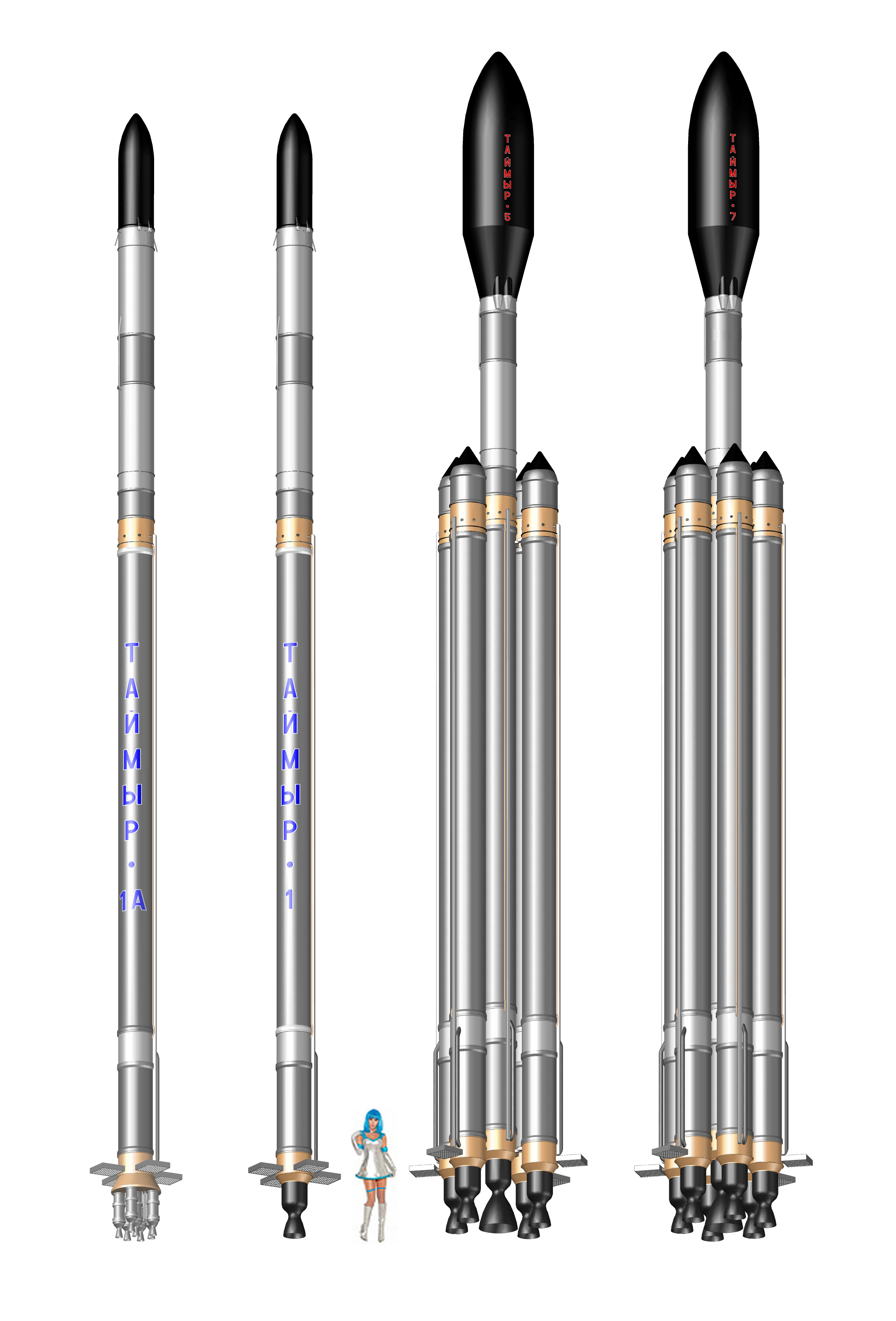
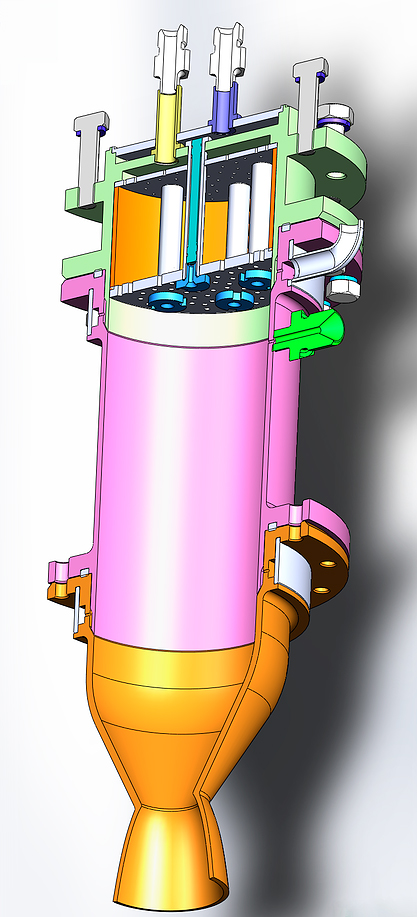
Costs and profits
Planned costs:
- Choice of launch vehicle concept
- Feasibility study
- Business plan
- Analysis and choice of subcontractors
- Patents
- Development of ground and transport equipment
- Rationale for the choice of control system concept
- Reports on payload integration, fueling procedure, telemetry provision, ground control stations, frequencies, electrical subsystem, pneumohydraulic scheme, dynamics of stage separation
- Preparation of 3D graphics and videos
- Participation in MAKS-2015 with a launch vehicle mockup
- Trial winding of tanks
- Static tests of the liquid rocket engine with ~100 kgf (981 N) thrust
- Tests of the control system prototype on subsonic and supersonic flying testbeds
Total cost — 10 mln rubles.
- Development of the liquid rocket engine with ~400 kgf thrust (3.9 kN) — 5 mln rubles
- Development of the launch vehicle prototype — 5 mln rubles
- Manufacture of the prototype — 10 mln rubles
- Control system — 5 mln rubles
- Static tests — 10 mln rubles
- Administrative expenses — 5 mln rubles
Total cost — 40 mln rubles
- Development of the powerplant consisting of 9 liquid rocket engines with 400 kgf thrust each — 15 mln rubles
- Serial production of the powerplant — 60 mln rubles
- 3D modeling of the launch vehicle design — 7 mln rubles
- Modeling software development — 15 mln rubles
- Purchase of equipment — 17 mln rubles
- Static tests — 5 mln rubles
- Dynamic tests — 10 mln rubles
- Ground equipment mockup — 12 mln rubles
- Thermal calculations — 2 mln rubles
- Power supply system development — 3 mln rubles
- Telemetry — 5 mln rubles
- Creation of a testbed for the complete first stage engine test firings — 5 mln rubles
- Creation of a mobile launch pad — 4 mln rubles
- Development of cable network — 2 mln rubles
- Test firings — 5 mln rubles
- Creation of a mission control center / staff training — 3 mln rubles
- Upgrade / creation of the launch infrastructure — 10 mln rubles
- Production of a series of powerplants for the first, second and third stages — 45 mln rubles
- Other components and assembly — 25 mln rubles
Total cost — 250 mln rubles
- Development of the liquid rocket engine with ~4 tf (40 kN) thrust — 40 mln rubles
- Development of the Taymyr-5 launch vehicle with payload of 100 kg — 20 mln rubles
- Production and launch of Taymyr-5 launch vehicle with payload of 100 kg — 60 mln rubles
Total cost — 120 mln rubles
- First stage and second stage engines — 30,800,000 rubles
- Third stage engine — 500,000 rubles
- Winding of tanks — 6,300,000 rubles
- Liner, fittings — 8,400,000 rubles
- Control system — 500,000 rubles
- Control surfaces and servos — 1,500,000 rubles
- Propellants — 14,000,000 rubles
- Launch staff services — 600,000 rubles
- Various electronic modules — 300,000 rubles
- Storage of the launch vehicle — 150,000 rubles
- Transportation — 600,000 rubles
- Wages and overhead costs — 3,000,000 rubles
- Insurance — 1,500,000 rubles
- Test range, impact sites — 4,000,000 rubles
- Operation of the ground control stations — 200,000 rubles
- Subtotal cost — 72,150,000 rubles
- Inflation rate for the development period — 1.2
- Appreciation rate induced by exchange rate risks — 1.2
- Total cost — 103,896,000 rubles
- Cost of 1 kg to LEO — 742,114 rubles
- Expected price of 1 kg to LEO — $40,000
- Exchange rate on May 20, 2015 — 50 rubles/$
- Expected price of 1 kg to LEO — 2,000,000 rubles
- Expected profit per launch — 176,104,000 rubles
Expected outline of profit-making
- Number of commercial launches with payload of 13 kg — 8
- Price per launch — $0.6 mln
- Commercial value of 1 kg in orbit — $60,000
- Profit per launch — $100,000
- Number of commercial launches with payload of 100 kg or more — 4
- Price per launch — at least $4 mln
- Commercial value of 1 kg in orbit — $40,000
- Profit per launch — at least $2.7 mln
| Year | 1 | 2 | 3 | 4 | 5 | |||||||||||||||
|---|---|---|---|---|---|---|---|---|---|---|---|---|---|---|---|---|---|---|---|---|
| Launch # | 1 | 2 | 3 | 4 | 5 | 6 | 7 | 8 | 9 | 10 | 11 | 12 | 13 | 14 | 15 | 16 | 17 | 18 | 19 | 20 |
| Costs, $ mln | 5 | 5 | 5 | 6,25 | 6,25 | 6,25 | 6,25 | 7,81 | 8,51 | 8,51 | 8,51 | 10,64 | 10,64 | 10,64 | 10,64 | 13,3 | 13,3 | 13,3 | 13,3 | 16,63 |
| Profits, $ mln | 0,1 | 0,2 | 0,3 | 0,4 | 0,5 | 0,6 | 0,7 | 0,8 | 3,5 | 6,2 | 8,9 | 11,6 | 14,3 | 17 | 19,7 | 22,4 | 25,1 | 27,8 | 30,5 | 33,2 |
Note: The discount rate is 25%
Figure 3. The project's rate of return

Therefore, after 2.5 years and 11 launches the project reaches break-even point and becomes profitable.
History and current status
In the beginning of 2014 Lin Industrial started the development of the Adler minisat launch vehicle. In the spring of the same year after meeting potential investors and experts, who recognized the project as too expensive for a small startup, and Russian developers of nanosats and microsats, who expressed the need for a Russian nanosat launch vehicle, the development was started for the Taymyr microsat launch vehicle, and finished in general in the fall of the same year. In winter venture capitalists became interested in the project, and provided the funding for further development. In April 2015 the project was approved by the experts from the Space Technologies and Telecommunications Cluster of the Skolkovo Foundation.
In partnership with Department 202 of the Moscow Aviation Institute (MAI), a liquid rocket engine prototype is being developed and prepared for testing. The engine is manufactured by the ArtMech engineering center. The first version of the preliminary design of launch vehicle has been created, and its refinement is in progress. We have signed cooperation agreements with Russian satellite manufacturers SPUTNIX and Quazar Space — these companies expressed their interest in launching their satellites by Taymyr.
In 2015 our several flying testbeds made successful flights for testing the prototype of the Taymyr flight control system.
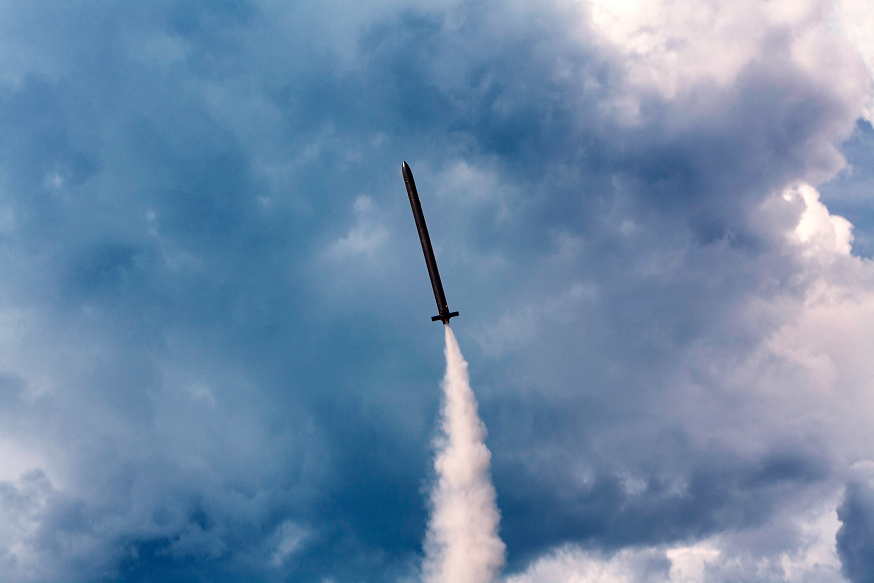
In August 2015 the project was exhibited at MAKS 2015.
The first static tests of the engine are planned for 2016.
The first space launch is planned for Q1 2020 (Taymyr-1A).
See also Taymyr Questions & Answers
